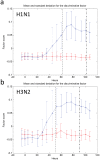A host transcriptional signature for presymptomatic detection of infection in humans exposed to influenza H1N1 or H3N2
- PMID: 23326326
- PMCID: PMC3541408
- DOI: 10.1371/journal.pone.0052198
A host transcriptional signature for presymptomatic detection of infection in humans exposed to influenza H1N1 or H3N2
Abstract
There is great potential for host-based gene expression analysis to impact the early diagnosis of infectious diseases. In particular, the influenza pandemic of 2009 highlighted the challenges and limitations of traditional pathogen-based testing for suspected upper respiratory viral infection. We inoculated human volunteers with either influenza A (A/Brisbane/59/2007 (H1N1) or A/Wisconsin/67/2005 (H3N2)), and assayed the peripheral blood transcriptome every 8 hours for 7 days. Of 41 inoculated volunteers, 18 (44%) developed symptomatic infection. Using unbiased sparse latent factor regression analysis, we generated a gene signature (or factor) for symptomatic influenza capable of detecting 94% of infected cases. This gene signature is detectable as early as 29 hours post-exposure and achieves maximal accuracy on average 43 hours (p = 0.003, H1N1) and 38 hours (p-value = 0.005, H3N2) before peak clinical symptoms. In order to test the relevance of these findings in naturally acquired disease, a composite influenza A signature built from these challenge studies was applied to Emergency Department patients where it discriminates between swine-origin influenza A/H1N1 (2009) infected and non-infected individuals with 92% accuracy. The host genomic response to Influenza infection is robust and may provide the means for detection before typical clinical symptoms are apparent.
Conflict of interest statement
Figures




Similar articles
-
A host-based RT-PCR gene expression signature to identify acute respiratory viral infection.Sci Transl Med. 2013 Sep 18;5(203):203ra126. doi: 10.1126/scitranslmed.3006280. Sci Transl Med. 2013. PMID: 24048524 Free PMC article.
-
microRNAs in circulation are altered in response to influenza A virus infection in humans.PLoS One. 2013 Oct 7;8(10):e76811. doi: 10.1371/journal.pone.0076811. eCollection 2013. PLoS One. 2013. PMID: 24116168 Free PMC article.
-
Differential evolution of peripheral cytokine levels in symptomatic and asymptomatic responses to experimental influenza virus challenge.Clin Exp Immunol. 2016 Mar;183(3):441-51. doi: 10.1111/cei.12736. Epub 2015 Dec 16. Clin Exp Immunol. 2016. PMID: 26506932 Free PMC article.
-
Emergency surveillance of influenza during 2009 in the Chinese city of Qingdao.Influenza Other Respir Viruses. 2011 Jan;5(1):53-9. doi: 10.1111/j.1750-2659.2010.00159.x. Epub 2010 Aug 24. Influenza Other Respir Viruses. 2011. PMID: 21138541 Free PMC article.
-
[Swine influenza virus: evolution mechanism and epidemic characterization--a review].Wei Sheng Wu Xue Bao. 2009 Sep;49(9):1138-45. Wei Sheng Wu Xue Bao. 2009. PMID: 20030049 Review. Chinese.
Cited by
-
A miRNA Host Response Signature Accurately Discriminates Acute Respiratory Infection Etiologies.Front Microbiol. 2018 Dec 11;9:2957. doi: 10.3389/fmicb.2018.02957. eCollection 2018. Front Microbiol. 2018. PMID: 30619110 Free PMC article.
-
Correlation-based iterative clustering methods for time course data: The identification of temporal gene response modules for influenza infection in humans.Infect Dis Model. 2016 Sep 2;1(1):28-39. doi: 10.1016/j.idm.2016.07.001. eCollection 2016 Oct. Infect Dis Model. 2016. PMID: 29928719 Free PMC article.
-
KLRD1-expressing natural killer cells predict influenza susceptibility.Genome Med. 2018 Jun 14;10(1):45. doi: 10.1186/s13073-018-0554-1. Genome Med. 2018. PMID: 29898768 Free PMC article.
-
Immunologic characterization of a rhesus macaque H1N1 challenge model for candidate influenza virus vaccine assessment.Clin Vaccine Immunol. 2014 Dec;21(12):1668-80. doi: 10.1128/CVI.00547-14. Epub 2014 Oct 8. Clin Vaccine Immunol. 2014. PMID: 25298110 Free PMC article.
-
Influenza-Omics and the Host Response: Recent Advances and Future Prospects.Pathogens. 2017 Jun 10;6(2):25. doi: 10.3390/pathogens6020025. Pathogens. 2017. PMID: 28604586 Free PMC article. Review.
References
-
- Lambert SB, Whiley DM, O'Neill NT, Andrews EC, Canavan FM, et al. (2008) Comparing nose-throat swabs and nasopharyngeal aspirates collected from children with symptoms for respiratory virus identification using real-time polymerase chain reaction. Pediatrics 122: e615–620. - PubMed
Publication types
MeSH terms
Grants and funding
LinkOut - more resources
Full Text Sources
Other Literature Sources
Medical
Molecular Biology Databases

